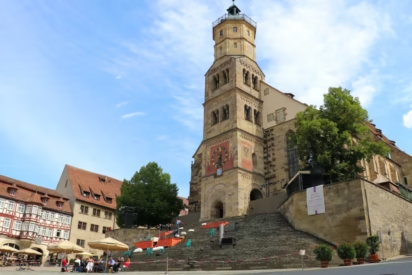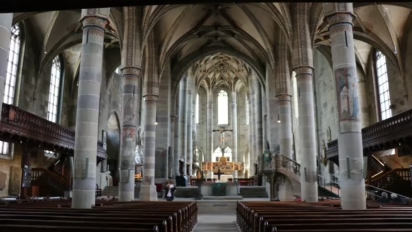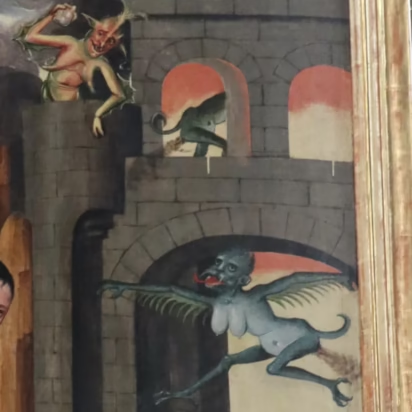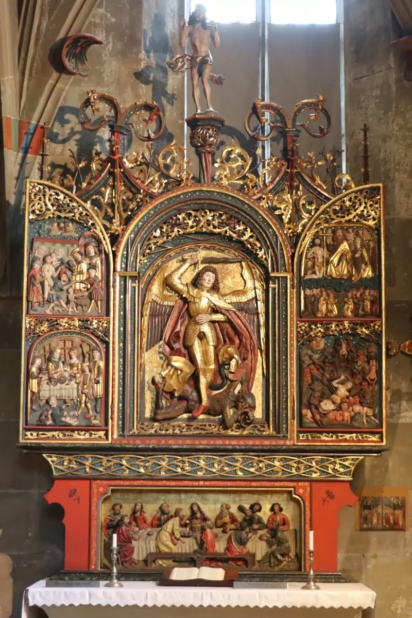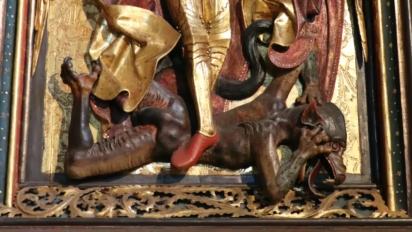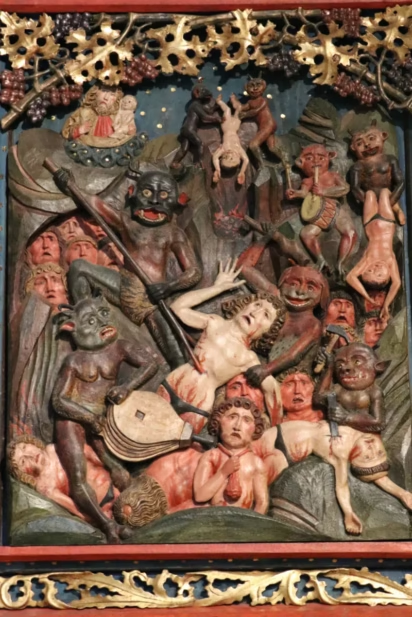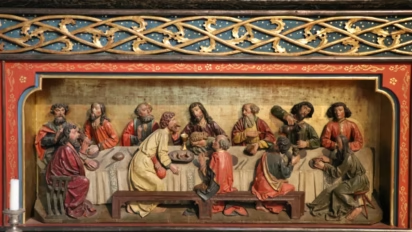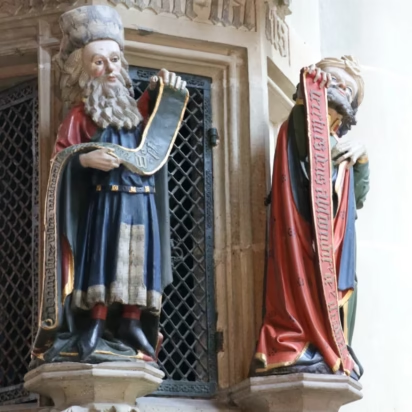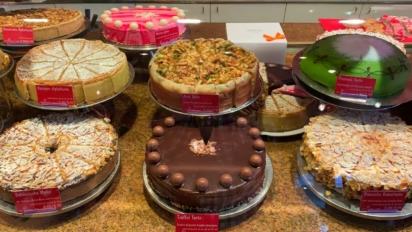St Michael’s in Schwäbisch Hall is a late Gothic church with magnificent vaulting and a surprising amount of art for a Lutheran church.

The St Michaelskirche is the main church in the picturesque village Schwäbisch Hall in Baden-Württemberg in southern Germany. It is a mostly late Gothic church with an impressive choir and elegant vaulting. The interior is filled with art including many items from before the Reformation — something that is not that common in this region where iconoclasm was rife in the early 16th century. Visitors may enjoy views from the church tower or from the wide set of stairs that are frequently used for open-air concerts.
St Michael’s in Schwäbisch Hall
The original St Michaelkirche was a triple-nave Romanesque basilica inaugurated in 1156. Of this church, only the western portal with a large sculpture of the archangel Michael and the lower floors of the tower survived.
The Romanesque basilica was replaced by a late Gothic hall church in 1427 to 1457. It measures 33 by 25 m with a relatively low height of 13.5 m.
The choir with its higher and very impressive late Gothic vaulting was added between 1495 and 1525. It is at 31 by 25 m only moderately smaller than the nave but the vaulting soars to a height of 19.5 m.
Plans to add a new Gothic tower never came to fruition. Instead, the two octagonal floors and a lantern for the bells were added to the existing Romanesque tower in 1539-73 to raise the height to 46.5 m. It is around 160 steps to the ten bells — the oldest dates from 1260.
The 53 steps of the wide staircase leading from the market square up to the west portal are probably the most memorable aspects of the exterior of the St Michaelskirche in Schwäbisch Hall. These were built in the early 16th century and have formed the stage for popular outdoor plays performed in summer since 1925.
Interior of the Michaelskirche in Schwäbisch Hall
Schwäbisch Hall accepted the Lutheran Reformation as early as 1522 under the capable leadership of Johannes Brenz (1499-1570). He opposed the iconoclasm that led to the destruction of many medieval artworks in other parts of Swabia during the early Reformation period.
As a result, the Michaelskirche is still filled with a remarkable ensemble of religious art that is rare in many Lutheran churches. Many of the veneration statues were banished to the attic and several are now on display in the nearby free Hällisch-Fränkisches Museum. The church still has eight altars on display, 56 epitaphs, 31 graves (plus 31 graves on the outside), and further painted walls and pillars.
Large Altars in St Michael’s

The large high altar showing the passion and resurrection of Christ is the dominant art item in St Michael’s. It dates from 1460 and was made by Dutch artists.
The central section is busy with wood-carved figures bundled into four scenes: carrying of the cross, crucifixion, descending from the cross, and the mourning women. The paintings on the insides of the wings (from left): Jesus before King Herod, Jesus before Pilate (and the symbolic washing of hands), Jesus has risen, Jesus freeing Adam and Eve and the righteous from limbo. On the outside of the wings are bishops Augustine and Ambrosia, Cardinal Hieronymus, and Pope Gregory.
On the predella are paintings of Christ at the center, then from left Saints Michael, John the Baptist, George, and Peter, and to the right the symbols of the Evangelist: John, Mark, Luke, and Matthew.

The Holy Spirit altar is an unpainted wood carving from 1520. It shows the holy ghost descending on the apostles during Pentecost with further carvings of the entry into Jerusalem, doubting Thomas, the ascension, and death of Maria. The predella is an interesting carving of the Last Supper.
The Michaelsaltar is another wood-carved altar from around 1520. It shows the archangel Michael — he is depicted 15 times inside and outside the church that carries his name — subduing the devil in the form of a dragon. The panel on the left shows charity to the poor, the rich man and poor Lazarus, and on the right the final judgment and hell. On the predella is another Last Supper.
The best carved altars in the region are certainly Tilman Riemenschneider’s Holy Blood Altar in Rothenburg ob der Tauber and the Marienaltar in Creglingen.
More Art in the Michaelskirche in Schwäbisch Hall
The church has many further altars and artworks in both the choir and nave. The tall filigree Gothic sacrament house is from 1438 and the Holy Grave with mourners from 1455. The large Crucifix from 1494 is by Michael Erhart.
The sculpture set of the Entombment of Christ is from 1456 and was enhanced later by the crucifixion (1510), the descent from the cross (1510), and further figures in 1520.
Amongst the oddities in the choir is a mammoth tusk that was discovered in the 16th century and long considered to have been a unicorn horn. The grisly bones are from a medieval bone-house, where leftover remains where kept when graves were reused. These were only rediscovered under the choir in 1963. The bone house, first mentioned in 1400, was back then outside the Romanesque church and only ended up underneath the choir when the new Gothic structure was built.
Epitaphs in the church date from middle ages to the flamboyant high baroque. One is for the Bonhoeffer family, ancestors of Dietrich Bonhoeffer (1906-1945) — a prominent theologian opposing the Nazis. Note the one for a certain Romig — he died in 1589, aged 85, at which time he had 171 descendants.
St Michael’s Church Schwäbisch Hall Visitors Information
The Michaelskirche in Schwäbsich-Hall is open to visitors:
March to mid-November:
- Monday — noon to 17:00
- Tuesday to Sunday — 10:00 to 17:00
Mid-November to February:
- Monday — noon to 15:00
- Tuesday to Sunday — 11:00 to 15:00
Sightseeing is not possible during services, including usually at 10:00 on Sunday mornings.
Schwäbisch Hall is a picture-perfect town with many bakeries and restaurants. The Cafe am Markt on the market square at the bottom of the staircase below to the church does not only bake marvelously photogenic cakes but slice them generously too.
More art and cultural-historical objects may be seen in the nearby free Hällisch-Fränkisches Museum of local history. Across the Kocher River, on the far side of the town center is a free exhibition of the Worth Collection’s medieval art in the Johanniterkirche while admission is also free to the modern art exhibition in the Kunsthalle Würth.
